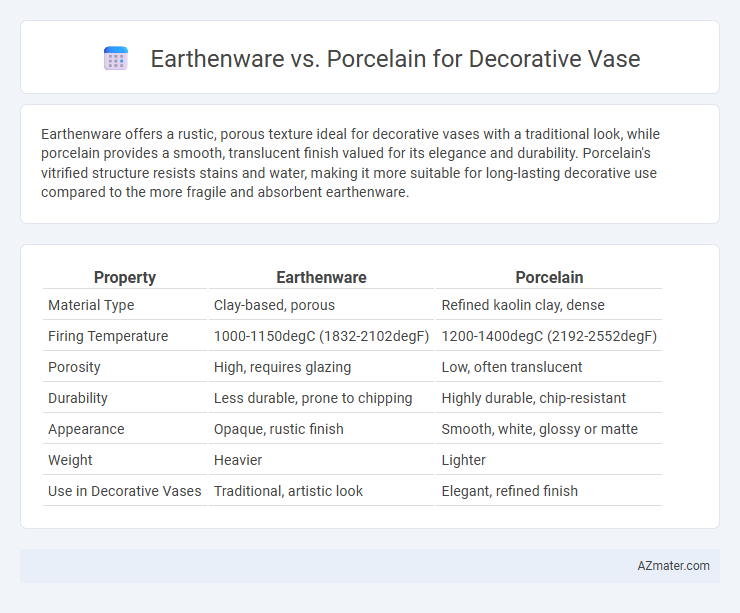Earthenware offers a rustic, porous texture ideal for decorative vases with a traditional look, while porcelain provides a smooth, translucent finish valued for its elegance and durability. Porcelain's vitrified structure resists stains and water, making it more suitable for long-lasting decorative use compared to the more fragile and absorbent earthenware.
Table of Comparison
| Property | Earthenware | Porcelain |
|---|---|---|
| Material Type | Clay-based, porous | Refined kaolin clay, dense |
| Firing Temperature | 1000-1150degC (1832-2102degF) | 1200-1400degC (2192-2552degF) |
| Porosity | High, requires glazing | Low, often translucent |
| Durability | Less durable, prone to chipping | Highly durable, chip-resistant |
| Appearance | Opaque, rustic finish | Smooth, white, glossy or matte |
| Weight | Heavier | Lighter |
| Use in Decorative Vases | Traditional, artistic look | Elegant, refined finish |
Introduction to Earthenware and Porcelain Vases
Earthenware vases are crafted from clay fired at lower temperatures, resulting in a porous, rustic texture often finished with colorful glazes that highlight their handcrafted appeal. Porcelain vases, made from kaolin clay and fired at higher temperatures, exhibit a smooth, translucent surface prized for its durability and delicate elegance. Both materials offer unique aesthetic qualities, with earthenware embodying warmth and tradition, while porcelain provides refinement and longevity for decorative use.
Key Material Differences: Earthenware vs Porcelain
Earthenware is a porous, coarse ceramic fired at lower temperatures, typically between 1,000degC and 1,150degC, resulting in a softer, more porous material that requires glazing for water resistance. Porcelain, made from refined kaolin clay and fired at higher temperatures ranging from 1,200degC to 1,450degC, produces a dense, non-porous, and translucent material known for its strength and durability. These fundamental material differences influence the appearance, weight, and functional qualities of decorative vases, making porcelain more suitable for fine, delicate designs and earthenware ideal for rustic or traditional styles.
Appearance and Aesthetic Qualities
Earthenware vases exhibit a rustic, matte finish with earthy tones that highlight natural imperfections, creating a cozy, handmade aesthetic ideal for casual decor. Porcelain vases showcase a smooth, glossy surface with translucent qualities and refined detailing, offering an elegant, sophisticated look suitable for formal settings. The vibrant glaze and delicate craftsmanship of porcelain contrast sharply with the warm, textured appeal of earthenware, influencing the overall decorative impact.
Durability and Strength Comparison
Earthenware vases offer a porous, less dense structure that makes them more prone to chipping and cracking compared to porcelain. Porcelain, known for its high-fired vitrification process, provides superior strength and durability, making it ideal for long-lasting decorative vases. The non-porous surface of porcelain also enhances resistance to moisture and wear, ensuring extended lifespan in home decor applications.
Porosity and Water Resistance
Earthenware vases exhibit higher porosity, making them more absorbent and less water-resistant compared to porcelain. Porcelain's dense, vitrified structure provides superior water resistance, preventing moisture penetration and enhancing durability. This distinction makes porcelain vases ideal for long-lasting decorative use where water exposure is a concern.
Artistic Potential and Decorative Techniques
Earthenware offers a rustic, porous surface ideal for hand-painted, textured finishes and glazing techniques that enhance its artistic charm in decorative vases. Porcelain provides a smooth, fine-grained canvas allowing for intricate detailing, translucent glazes, and sophisticated decorative methods such as gilding and overglaze enameling. The choice between earthenware and porcelain significantly impacts the vase's aesthetic potential, with earthenware favoring bold, earthy artistry and porcelain enabling delicate, refined ornamentation.
Price and Value Considerations
Earthenware vases are generally more affordable due to their lower firing temperatures and porous nature, making them accessible for budget-conscious buyers seeking rustic charm. Porcelain vases command higher prices because of their fine, dense composition and high firing temperature, offering greater durability and a refined, translucent appearance that enhances long-term value. Choosing between earthenware and porcelain depends on the desired balance between initial cost and lasting aesthetic appeal, with porcelain providing superior investment value despite the higher upfront price.
Maintenance and Care Requirements
Earthenware vases require gentle cleaning with a soft cloth and mild soap to prevent chipping due to their porous and softer nature. Porcelain vases demand minimal maintenance, as their dense, non-porous surface resists stains and scratches, allowing easy cleaning with water and mild detergents. Proper care ensures longevity and aesthetic preservation for both earthenware and porcelain decorative vases.
Best Uses: Matching Vases to Interior Styles
Earthenware vases suit rustic, bohemian, and farmhouse interiors due to their porous texture and earthy tones, adding warm, natural charm. Porcelain vases complement modern, minimalist, and classic decor with their smooth, glossy finish and delicate, refined appearance, enhancing elegance. Choosing between earthenware and porcelain depends on the desired aesthetic impact, where earthenware offers organic appeal and porcelain provides sophisticated shine.
Conclusion: Choosing the Right Vase Material
Earthenware offers a rustic charm and affordability, making it ideal for casual or outdoor decorative vases, while porcelain provides a refined, translucent finish with superior durability suitable for elegant indoor displays. Consider the environment and aesthetic purpose, as earthenware's porous nature requires glazing for moisture protection, whereas porcelain's vitrified surface resists moisture and staining naturally. Selecting between earthenware and porcelain depends on balancing budget, durability needs, and desired visual appeal for the decorative vase.

Infographic: Earthenware vs Porcelain for Decorative Vase
 azmater.com
azmater.com